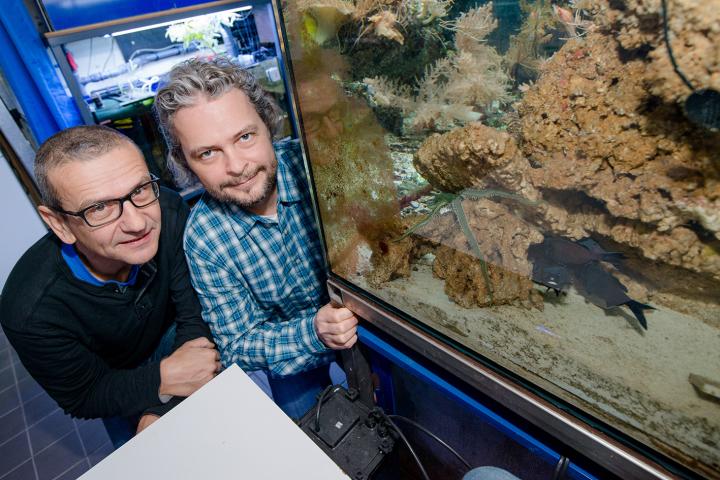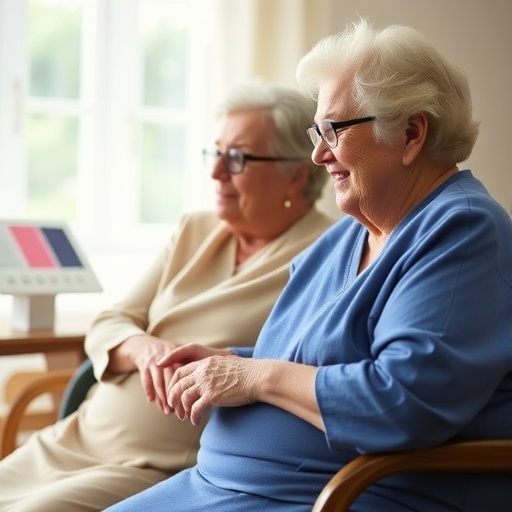
Credit: RUB, Marquard
The researchers thus identified the purposes of bioluminescence in this fish species. The same question still remains open for many other glowing marine creatures. The researchers published their report in the current Plos One edition.
Light organs rotate backwards
Flashlight fish, also referred to as lantern-eye fish, live in swarms of eight to 50 animals that hunt plankton on coral reef roofs at night. During the day, the fish withdraw to a depth of up to 400 metres, where they presumably rest in underwater caves. They have light organs below their eyes which can be rotated backwards and which contain bioluminescent symbiotic bacteria. By rotating their light organs, the fish generate flash patterns in different frequencies. To date, researchers could only speculate about the light organs function. "Deploying methods of behavioural biology, we have now successfully demonstrated that Anomalops katoptron uses its light organs while foraging, and it adjusts the flash frequency to the context in which it operates," as Stefan Herlitze and Jens Hellinger explain. For their analysis, the researchers utilised watertight infrared spotlights, developed in collaboration with the faculty workshop for this specific purpose.
Constant glow during feeding
They observed that the fish blink 90 times per minute on average during the night. Once the researchers add zooplankton to the water, the animals promptly reduce their flash frequency and emit an almost continuous glow while feeding. Non-glowing control animals of the same species hardly ever caught any prey. They didn't exhibit any changes to blink frequency in the presence of zooplankton, either. The blink frequency in non-glowing fish can be determined by monitoring light organ rotation. "The results clearly indicate that Anomalops katoptron relies on its light organs while foraging for food," conclude Stefan Herlitze and Jens Hellinger.
Moreover, the researchers have demonstrated that the animal' blink frequency is also regulated by the lighting conditions in their environment. During the day, the animals rest in the reef aquarium in a dimly lit cave, keeping their light organs closed for the most part, interrupted only by brief blinks. During their active phase at night, on the other hand, the fish exhibit a high blink frequency. The precise function of that blink pattern is not yet fully understood. Additional analyses will reveal whether the fish use blink patterns to communicate or whether they confuse predators by blinking in a swarm.
Close symbiosis
Anatomical thin-section analyses that the researchers performed on light organs of luminescent and non-luminescent fish have revealed marked differences in the macroscopic and microscopic structures: light organs of luminescent fish contain tightly packed tubules which house living, glowing bacteria; once the light organs stop glowing and lose the bacteria, holes form in the tubule structure. The structural transformation following the loss of luminescence suggests a close symbiosis between fish and bacteria. The loss of luminescence is caused by food shortage.
Bioluminescence explained
Generation of light by organisms is common in nature. The by far most instances of luminescent organisms occur in marine habitats and can be found in numerous systematic groups. Approx. 90 per cent of all deep-sea animals are bioluminescent. Among vertebrates, fish are the only ones to display bioluminescence. Fish either possess photophores where they generate light, or they accommodate symbiotic bacteria that emit light. That light may be used for communication, for luring in prey organisms, or for defence; in many instances, the precise function is not obvious, and it is difficult to analyse it in deep-sea organisms. "Due to extreme pressure differences, it's virtually impossible to bring the fish to the surface without harming them," say Stefan Herlitze and Jens Hellinger. The flashlight fish Anomalops katoptron is an exception. As it lives in relatively shallow waters, it can be kept in an aquarium.
###
Original publication
Jens Hellinger, Peter Jägers, Marcel Donner, Franziska Sutt, Melanie D. Mark, Budiono Senen, Ralph Tollrian und Stefan Herlitze: The Flashlight Fish Anomalops katoptron Uses Bioluminescent Light to Detect Prey in the Dark, in: Plos One, 2017, DOI: 10.1371/journal.pone.0170489, http://journals.plos.org/plosone/article?id=10.1371/journal.pone.0170489
Media Contact
Stefan Herlitze
[email protected]
49-234-322-4363
@ruhrunibochum
http://www.ruhr-uni-bochum.de
############
Story Source: Materials provided by Scienmag





